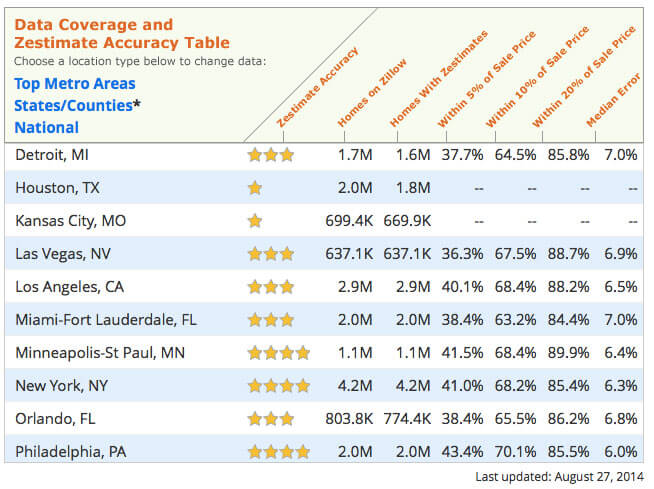Zillow Zestimate Analysis not everything you read & find in the web is true
The Zestimate® home value is Zillow’s estimated market value for an individual home and is calculated for about 100 million homes nationwide. It is a starting point in determining a home’s value and is not an official appraisal. The Zestimate is automatically computed three times per week based on millions of public and user-submitted data points.
The Zestimate® home valuation is Zillow’s estimated market value, computed using a proprietary formula. It is not an appraisal. It is a starting point in determining a home’s value. The Zestimate is calculated from public and user submitted data; your real estate agent or appraiser physically inspects the home and takes special features, location, and market conditions into account.
We encourage buyers, sellers, and homeowners to supplement Zillow’s information by doing other research such as:
Getting a comparative Market Analysis (CMA) from a real estate agent. Getting an appraisal from a professional appraiser. Visiting the house (whenever possible)
How Accurate is the Estimate?
The Zestimate’s accuracy depends on location and availability of data in an area. Some counties have deeply detailed information on homes such as number of bedrooms, bathrooms and square footage and others do not. The more data available, the more accurate the Zestimate.
Data Coverage and Zestimate Accuracy
Nationally, the Zestimate has a median error rate of 7%, which means half of the Zestimates in an area are closer than the error percentage and half are farther off. For example, in Seattle, Zestimates for half of the homes are within 6.6% of the selling price, and half are off by more than 6.6%. To improve Zestimate accuracy, we allow homeowners to edit their home facts and then we incorporate this information into our Zestimate calculations.
To improve Zestimate accuracy, we allow homeowners to edit their home facts and then we incorporate this information into our Zestimate calculations.Be aware that in some areas, we might not be not be able to produce a Zestimate at all, but we do have some basic information on the homes.
The table below show you where we have Zestimates and other home information.

Definitions
Zestimate Accuracy – Star Rating
This rating is tied to the Median Error in an area. The ratings are as follows:
- 4 star = Best Zestimate.
- 3 star = Good Zestimate.
- 2 star = Fair Zestimate.
- 1 star = Tax assessor’s value, or unable to compute Zestimate accuracy.
- 0 star = No valuation.
Homes on Zillow
This indicates the percentage of homes for which we have data (e.g., number of bedrooms or bathrooms) in a particular locale. These are the homes you can find via maps or search on zillow.com.
Homes With Zestimates
We can only calculate Zestimates for homes where we have certain data, including transactions. This column indicates the percentage of homes in an area with Zestimates.
Within 5% of Sale Price
This is the percentage of transactions in a location for which the Zestimate was within 5% of the transaction price. Nationwide, Zestimates are currently within 5% of the final sale price 38.4% of the time.
Within 10% of Sale Price
This is the percentage of transactions in a location for which the Zestimate was within 10% of the transaction price. In the U.S. as a whole, Zestimates are currently within 10% of the final sale price 63.6% of the time.
Within 20% of Sale Price
This is the percentage of transactions in a location for which the Zestimate was within 20% of the transaction price. Nationally, Zestimates are currently within 20% of the final sale price 83.1% of the time.
Median Error
Half of the Zestimates in an area were closer than the error percentage and half were farther off. The median error rate for the country is currently 6.9%, meaning half of Zestimates nationwide were within 6.9% of the final selling price, and half are off by more than 6.9%.
Are foreclosure sales included in the Zestimate algorithm?
No, the Zestimate is intended to provide an estimate of the price that a home would fetch if sold in a full-value, arms-length sale (e.g., the sale isn’t for partial ownership of the property or between family members).
Our extensive analysis of foreclosure re-sales (typically, but not always, real estate owned, or REO, sales) supports the conclusion that these sales are generally made at substantial discounts to comparable non foreclosure sales. As such, these sales are not used by the algorithm to produce the Zestimate.
That is not to say that foreclosure re-sales do not influence the Zestimate at all, as foreclosure re-sales do suppress the sale price of surrounding non-foreclosure homes, and the price signals from these surrounding homes are used by the algorithm to produce Zestimates in that area.
How can real estate pros work with the Zestimate?
Real estate professionals sometimes get inquiries from prospective real estate buyers and sellers about the Zestimate. Understanding how the Zestimate is calculated, along with its strengths and weaknesses, can provide the real estate pro with an opportunity to demonstrate their expertise.
Millions of consumers visit Zillow every month. Most understand that the Zestimate is exactly that, an estimate of the value of a home.
Occasionally however, someone will come along that insists on setting the price they are willing to buy or sell for based solely on the Zestimate. Education is the key. As a real estate professional one thing you are always doing is educating your clients on all things real estate.
The Zestimate is no different. Armed with an understanding of how the Zestimate is calculated and the Zestimate Data Accuracy table, you can explain – and show Zillow’s own accuracy numbers and talk about why the Zestimate is a good starting point as well as a historical reference, but it should not be used for pricing a home.
Be proactive. Look at what Zillow says about properties your client is interested in and bring up any concerns before your client does. “Zestimate calls” tend to come from consumers who are highly engaged and interested in real estate. If a consumer is to the point where they are examining Zestimates and pricing, they tend to be further along in their search for a home and agent than most.
If you want to know more about the real estate market, you can view these articles:
If you have questions about How to Invest in Miami and South Florida, or questions about the real estate market in Miami and South Florida, contact us.






